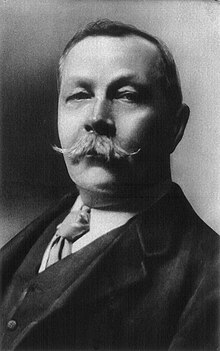About the Book: "The Adventure of the Missing Three-Quarter", one of the 56 Sherlock Holmes short stories written by British author Sir Arthur Conan Doyle, is one of 13 stories in the cycle collected as The Return of Sherlock Holmes. It was originally published in Strand Magazine in 1904 with illustrations by Sidney Paget.
About the Author: Arthur Ignatius Conan Doyle was born on 22 May 1859 at 11 Picardy Place, Edinburgh, Scotland. From 1876 to 1881, he studied medicine at the University of Edinburgh, including a period working in the town of Aston (now a district of Birmingham) and in Sheffield, as well as in Shropshire at Ruyton-XI-Towns. While studying, Doyle began writing short stories. His earliest extant fiction, "The Haunted Grange of Goresthorpe", was unsuccessfully submitted to Blackwood's Magazine. His first published piece "The Mystery of Sasassa Valley", a story set in South Africa, was printed in Chambers's Edinburgh Journal on 6 September 1879. On 20 September 1879, he published his first non-fiction article, "Gelsemium as a Poison" in the British Medical Journal. In 1882 he joined former classmate George Turnavine Budd as his partner at a medical practice in Plymouth, but their relationship proved difficult, and Doyle soon left to set up an independent practice. Arriving in Portsmouth in June of that year with less than £10 (£900 today) to his name, he set up a medical practice at 1 Bush Villas in Elm Grove, Southsea. The practice was initially not very successful. While waiting for patients, Doyle again began writing stories and composed his first novels, The Mystery of Cloomber, not published until 1888, and the unfinished Narrative of John Smith, which would go unpublished until 2011. He amassed a portfolio of short stories including "The Captain of the Pole-Star" and "J. Habakuk Jephson's Statement", both inspired by Doyle's time at sea, the latter of which popularized the mystery of the Mary Celeste and added fictional details such as the perfect condition of the ship (which had actually taken on water by the time it was discovered) and its boats remaining on board (the one boat was in fact missing) that have come to dominate popular accounts of the incident. Doyle struggled to find a publisher for his work. His first significant piece, A Study in Scarlet, was taken by Ward Lock Co. on 20 November 1886, giving Doyle £25 for all rights to the story. The piece appeared later that year in the Beeton's Christmas Annual and received good reviews in The Scotsman and the Glasgow Herald. The story featured the first appearance of Watson and Sherlock Holmes, partially modeled after his former university teacher Joseph Bell. Doyle wrote to him, "It is most certainly to you that I owe Sherlock Holmes ... Round the center of deduction and inference and observation which I have heard you inculcate I have tried to build up a man." Robert Louis Stevenson was able, even in faraway Samoa, to recognize the strong similarity between Joseph Bell and Sherlock Holmes: "My compliments on your very ingenious and very interesting adventures of Sherlock Holmes. ... Can this be my old friend Joe Bell?" Other authors sometimes suggest additional influences—for instance, the famous Edgar Allan Poe character C. Auguste Dupin. A sequel to A Study in Scarlet was commissioned and The Sign of the Four appeared in Lippincott's Magazine in February 1890, under agreement with the Ward Lock company. Doyle felt grievously exploited by Ward Lock as an author new to the publishing world and he left them. Short stories featuring Sherlock Holmes were published in the Strand Magazine. Doyle first began to write for the 'Strand' from his home at 2 Upper Wimpole Street, now marked by a memorial plaque. In this period, however, Holmes was not his sole subject and in 1893, he collaborated with J.M. Barrie on the libretto of Jane Annie. Doyle was found clutching his chest in the hall of Windlesham Manor, his house in Crowborough, East Sussex, on 7 July 1930. He died of a heart attack at the age of 71. His last words were directed toward his wife: "You are wonderful." At the time of his death, there was some controversy concerning his burial place, as he was avowedly not a Christian, considering himself a Spiritualist. He was first buried on 11 July 1930 in Windlesham rose garden. He was later re-interred together with his wife in Minstead churchyard in the New Forest, Hampshire. Carved wooden tablets to his memory and to the memory of his wife are held privately and are inaccessible to the public. That inscription reads, "Blade straight / Steel true / Arthur Conan Doyle / Born May 22nd 1859 / Passed On 7th July 1930." The epitaph on his gravestone in the churchyard reads, in part: "Steel true/Blade straight/Arthur Conan Doyle/Knight/Patriot, Physician, and man of letters". Undershaw, the home near Hindhead, Haslemere, south of London, that Doyle had built and lived in between October 1897 and September 1907, was a hotel and restaurant from 1924 until 2004. It was then bought by a developer and stood empty while conservationists and Doyle fans fought to preserve it. In 2012 the High Court ruled that the redevelopment permission be quashed because proper procedure had not been followed. A statue honors Doyle at Crowborough Cross in Crowborough, where he lived for 23 years. There is also a statue of Sherlock Holmes in Picardy Place, Edinburgh, close to the house where Doyle was born.
My Review: In this story, Mr. Cyril Overton of Trinity College, Cambridge comes to Holmes seeking his help in Godfrey Staunton’s disappearance. Staunton is the key man on Overton’s rugby team (who plays at the three-quarters position, hence the story's title), and they will never win the important match tomorrow against Oxford if Staunton cannot be found. Holmes has to admit that sport is outside his field, but he shows the same care he has shown to his other cases.
Staunton had seemed a bit pale and bothered earlier in the day, but late in the evening, according to a hotel porter, a rough-looking, bearded man came to the hotel with a note for Staunton which, judging from Staunton’s reaction, contained rather devastating news. He then left the hotel with the bearded stranger, and the two of them were seen running in the direction of the Strand at about half past ten. No-one has seen them since.
Overton has wired to Cambridge to find out if Staunton has been seen there; he has not. He has also wired Lord Mount-James, Staunton’s very wealthy and thoroughly miserly uncle and nearest living kin, but has heard no answer. Staunton is the almost-eighty-year-old Lord Mount-James’s heir, but he must meanwhile live in relative poverty owing to his uncle’s miserly behavior.
At the hotel, Holmes questions the porter. This bearded man who brought the note was neither a gentleman nor a workman, and he seemed to be bothered by something, too, for his hand was trembling as he handed Staunton the note. The only word that the porter overheard of their short conversation was “time”.
At six o’clock, the porter had brought Staunton a telegram, and he saw Staunton write a reply. Staunton told the porter that he would send it himself. Holmes looks at the telegraph forms in Staunton’s room, and then at the blotter, finally finding a clue. The impression on the blotter yields a part of the message that Staunton sent: “Stand by us for God’s sake”. Obviously at least one other person is involved (“us”), and there is some kind of danger. Other papers left in the room yield clues.
Lord Mount-James also briefly visits, and can give Holmes no useful information as to his nephew’s whereabouts. The old miser seems utterly aghast at the possibility that it might be a kidnapping whose object would be to extort his wealth.
Holmes and Dr. Watson then go to the telegraph office where Holmes uses a ruse to get the woman there to show him the counterfoil of the message that Staunton sent. It was addressed to Dr. Leslie Armstrong, an academic at Cambridge. They go to see him.
Dr. Armstrong tells Holmes that Staunton is an intimate friend of his. He does not react when told that Staunton has disappeared, and claims not to know where he is, and not to have seen him recently. He also says that Staunton is very healthy, but Holmes then produces one of Staunton’s papers, a thirteen-guinea bill from Dr. Armstrong. Furious, Armstrong refuses to answer any more questions, and denies that he had the telegram from Staunton. He then has his butler show Holmes and Watson out. They lodge at an inn just across the street from Armstrong’s, where they can watch him.
Holmes conducts some inquiries. A man in the yard before the inn tells Holmes that Armstrong, although not in actual medical practice, regularly rides in his brougham out into the country somewhere. The roundtrip seems to take about three hours. Holmes tries following the brougham on one of its outings, hiring a bicycle for the purpose. He is thwarted by Dr. Armstrong, who makes it quite clear that he is aware that Holmes is following him. He gives Holmes the slip.
The next day, Holmes’s inquiries in all the local villages come to naught; no-one has seen the doctor’s brougham passing through their village.
The mystery is at last unlocked by Pompey, a beagle-foxhound cross by appearance, who tracks the doctor’s brougham to a cottage in the countryside after Holmes had coated the wheels in aniseed oil. What Holmes finds is not pleasant. Staunton is there, but is grieving over his young wife, who has just died of consumption. Her existence was kept secret, because Lord Mount-James would not have approved of the marriage and would have disowned his nephew. Dr. Armstrong had told the woman’s father about her condition, and he, the bearded stranger, had unwisely told Staunton, who felt compelled to rush off forthwith.
As there is no broken law, Holmes decided to keep everything quiet.
I recommend this story to all readers that appreciate a very well written mystery.



No comments:
Post a Comment